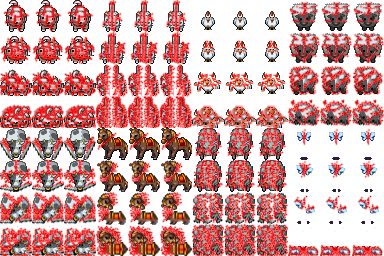Breaking News
Torrent La Familia Addams 3 1998
воскресенье 04 ноября admin 51
Having watched 'The Addams Family' when it originally ran and having seen the Addams Family movies, I'd have to say the New Addams Family series on FoxFamily is incredibly more pleasing and entertaining to me than I found the movies to be. I felt the casting of the original movie ruined its playfulness and really didn't have the same flavor as the 60's series. Glenn Taranto is eerily much more reminiscent of John Ashton and seems much happier and outgoing than Raul Julio was. He and Ellie Harvie portray the Addam's passions more frequently, but in such a carefree way it makes physical touch seem like a normal happy occurrence of two people in love instead of a segway to adult entertainment.
Nicole Fugere is an excellent Wednesday and steals the show. Both she and Brody Smith as Pugsly really bring out the children's parts (it is on a children's network) as two average children with just some seriously odd family values. The show is incredibly cast, better written than the movies I saw, and very entertaining; both my son and I love to watch it! It's one of the few 60's revivals that is actually a treat to watch. I just wish the production company would put up a web site for the show as the FoxFamily site is very limited.
Descargas de La Familia Adams 3 (La reunion de la familia Adams), Descarga directa, online, torrent y emule Inicio Foros Contacto Actualizaciones > La Familia Adams 3 (La reunion de la familia Adams). PDF HTML; Export citation. 3 - Disease and death. PDF HTML; Export citation. Part III - Logistical challenges. River transport.
Justification Justification of Red List Category This species has an extremely large range, and hence does not approach the thresholds for Vulnerable under the range size criterion (Extent of Occurrence 30% decline over ten years or three generations). The population size is extremely large, and hence does not approach the thresholds for Vulnerable under the population size criterion (10% in ten years or three generations, or with a specified population structure). For these reasons the species is evaluated as Least Concern. Population justification Rich et al. (2004) estimate the global population to number 2,000,000 individuals. In Europe, the breeding population is estimated to number 4,460,000-7,760,000 pairs, which equates to 8,930,000-15,500,000 mature individuals (BirdLife International 2015). Europe forms approximately 25% of the global range, so a very preliminary estimate of the global population size is 35,720,000-62,000,000 mature individuals, although further validation of this estimate is needed.

Download business environment books for mba pdf free. National population estimates include: c.100-10,000 breeding pairs and c.50-1,000 individuals on migration in China. Ecology For breeding, this species appears to require copious low dense vegetation with patches of open ground.  It breeds in ecotone habitats between forest and plain or open areas at tree-line, including wooded tundra, mountain steppe, subalpine scrub, marshland with low woody cover, clumps of willow ( Salix), alder ( Alnus) and birch ( Betula) on floodplains, riverbank thickets, reedy and shrub-dominated lakeshores, bushy sites near water. The breeding season is from late April to July in central Europe, from late May in Scandinavia, early April to June in Armenia, June-July in Ladakh, May-July in China and May/June-August in North America. The nest is a deep cup of leaves, small twigs, dry grass, rootlets, plant down and moss, which is occasionally lined with animal hair. It is placed among grass and scrub on wet ground and is commonly associated with topographic features such as a hummock, gulley, lip of a bank, or tussock.
It breeds in ecotone habitats between forest and plain or open areas at tree-line, including wooded tundra, mountain steppe, subalpine scrub, marshland with low woody cover, clumps of willow ( Salix), alder ( Alnus) and birch ( Betula) on floodplains, riverbank thickets, reedy and shrub-dominated lakeshores, bushy sites near water. The breeding season is from late April to July in central Europe, from late May in Scandinavia, early April to June in Armenia, June-July in Ladakh, May-July in China and May/June-August in North America. The nest is a deep cup of leaves, small twigs, dry grass, rootlets, plant down and moss, which is occasionally lined with animal hair. It is placed among grass and scrub on wet ground and is commonly associated with topographic features such as a hummock, gulley, lip of a bank, or tussock.
Clutches are four to seven eggs. The diet is principally invertebrates, particularly insects but it does take some seeds and fruit in the autumn (Collar 2015). The species is mainly migratory, with west Palearctic populations wintering in patches across the Mediterranean Basin and the northern Afrotropics and eastern populations in the Indian subcontinent (Snow and Perris 1998). Threats In Europe, this species experiences pronounced but largely unexplained population fluctuations (Hagemeijer and Blair 1997, Collar 2015). Some negative trends appear to be explained by natural succession in marshland, drainage and management practices such as reed-cutting, seedling removal and cattle grazing (Hagemeijer and Blair 1997), but recovery has taken place without the reversal of these circumstances. In Spain, during the 1990s it may have suffered from degradation of habitat through grazing and in Austria, significant losses have occurred during the 19th century due to drainage and it now faces threats there due to stabilization of lake levels, successional loss of reed-belt, and occupation of secondary habitats on arable land (where nest predation elevated) (Collar 2015).
